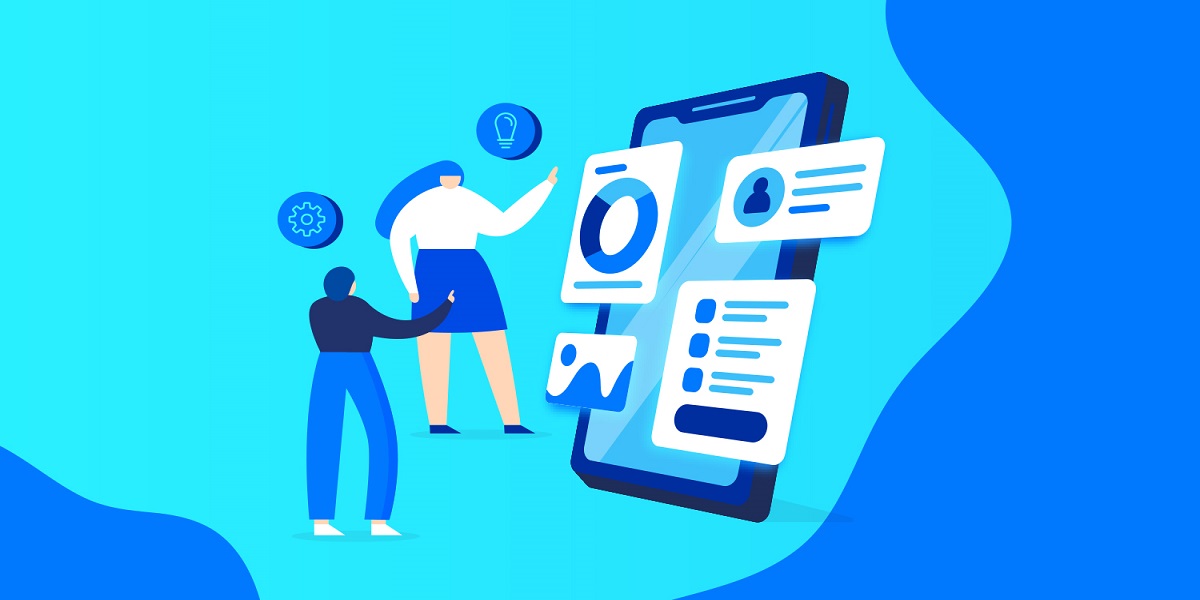Role of Mobile App Design Services for Successful App
Mobile Apps | 04-10-2023 | Atman Rathod

In today’s digital era, you can pretty much do anything with apps. Order food, book a ride, manage your money and more. There seems to be an app for everything. With millions of apps available on stores just looking for user attention and engagement it becomes a competition. And that’s where mobile app design comes into play.
It’s not just about aesthetics. But it’s everything from when they first open the app to when they finalize an interaction. User experience is a massive part of this, even how they feel when they use it. In this article we’ll get into why mobile app design is crucial in making successful apps and key things developers and designers should consider.
First impressions matter
While a book might not be judged by its cover, an app sure is. Users will often judge the quality and reliability of an app based solely off of its looks alone. An attractive icon with a welcoming UI will make users have a positive first impression.
Think about it: what’s the first thing you notice when you open any app? It's likely the app's logo or icon. A unique and memorable logo can make your app stand out in a sea of icons. Additionally, a visually appealing UI sets the tone for the user's entire journey within the app.
User Experience (UX) is Everything
It is said that the user experience is the most important thing. You don't have to create a masterpiece, but you do have to make it easy to use. To start, figure out where and when users get stuck. Doing so will also encourage users to stay on your app longer.
Think about it, is your app easy to understand? Are the most frequently used features readily accessible? Is the user guided through the app without confusion? A well-thought-out UX design anticipates user needs and streamlines the app's functionality.
Engagement and Retention
An engaging mobile app design keeps users coming back. Users are more likely to continue using an app that provides an enjoyable and visually pleasing experience. Features like gamification, interactive elements, and personalized content can significantly boost user engagement.
The truth is, people swipe left on frustrating apps faster than bad dates. One of the biggest causes of frustration is not being able to find things in your app. So think long and hard about where you put everything.
Branding and Recognition
Mobile app design is a powerful tool for branding. A consistent and well-executed design reinforces brand identity. From the color scheme to typography and iconography, every design element should align with your brand's values and message.
Brand recognition is vital in a crowded marketplace. When users recognize and trust your brand, they are more likely to choose your app over competitors. Think about how instantly recognizable icons like the Apple App Store or Facebook's "F" have become.
Performance Optimization
Design isn't limited to visuals; it also influences performance. A cluttered or overly complex design can slow down an app and increase loading times. On the other hand, a well-optimized design enhances performance, ensuring that the app runs smoothly and responds promptly to user inputs.
Performance optimization includes considerations like image compression, efficient code, and resource management. A seamless user experience relies on both design and performance working in harmony.
Accessibility and Inclusivity
Mobile app design has a critical aspect that we often overlook, accessibility. Think about the individuals with disabilities who may use your app, how do you make the experience equally as convenient for them? A few ways include screen readers, adjustable font sizes, and text-to-speech features.
Designing an app to be inclusive not only gives a wider range of users but is also an ethical choice. It shows your commitment to social responsibility which can make sure you don’t alienate any group. It's an essential aspect of modern app development.
Feedback and Iteration
Mobile app design is an ongoing process. Gathering user feedback and continuously iterating on the design is essential for long-term success. Users' preferences and needs evolve, and your app design should evolve with them.
Regular updates based on user feedback demonstrate your dedication to improving the app and provide opportunities to fix issues and add new features.
Competitive Advantage
In a highly competitive app market, design can be a key differentiator. A unique and innovative design sets your app apart from the competition. Users are more likely to choose an app that offers something visually distinctive and fresh.
Not just that, word-of-mouth marketing is also really strong with a good UX. When users have a good time with an app they will almost always recommend it.
Here are the key stages in the mobile application design process:
Concept and Research:
- Define Objectives: Begin by defining the purpose and goals of the mobile app. What problem will it solve, and for whom?
- Market Research: Research your target audience, competitors, and industry trends to gain insights into user preferences and market gaps.
- User Personas: Create user personas to represent your target audience, including their needs, preferences, and pain points.
- Feature List: Develop a list of features and functionalities that the app should include to meet user needs.
Wireframing:
- Sketching: Create rough sketches or wireframes of the app's layout and structure.
We start with placement. Where should buttons, menus, and content be? How do they blend together?
- User Flow: This is where we map out how users will navigate through the app. It includes the paths they’ll take to accomplish specific tasks.
Prototyping:
- Interactive Prototypes: Use prototyping tools to create interactive, clickable prototypes that simulate the app's functionality and user interactions.
- User Testing: Conduct user testing with the prototype to gather feedback and identify any usability issues or improvements needed.
Visual Design:
- UI Design: After figuring out where things go, we need to make them look good too. We select colors, typography, and visual elements that line up with branding and what users like.
- Iconography: Icons and graphics shouldn’t confuse people. So we make sure they’re intuitive and consistent with the overall design.
Responsive Design: We don’t want our app to look weird on different devices so we made sure it’s adaptable to every screen size.
Development and Testing:
- Front-End Development: Okay now we have to actually make this thing. Your designs are in code now so you can see your ideas come to life as you implement functionality.
- Back-End Development: The server-side components, databases, and APIs necessary for the app to function.
- Continuous Testing: We never stop testing this thing. Trying to find any issue before someone else does. Functionality, performance, security, and compatibility are all checked for.
- Bug Fixing: When something does go wrong during testing we’ll identify it and then fix it right away.
User Interface (UI) Animation:
- Micro-interactions: Implement micro-interactions, such as button animations and feedback animations, to enhance the user experience.
- Transitions: Design smooth transitions and animations between screens and elements for a polished and engaging UI.
User Testing and Feedback:
- Beta Testing: Give a selected group of users the beta version of the app for real-world testing and feedback.
- Usability Testing: Make sure the app is user-friendly and intuitive by conducting usability tests.
- Iterate: Use user feedback to make necessary improvements and refinements to the design and functionality.
Final Design and Development:
- Polishing: Refine the app's design, resolve any remaining issues, and optimize performance.
- Quality Assurance: Perform thorough testing, including regression testing, to ensure the app meets quality standards.
- Deployment: App Store Submission: Prepare and submit the app to app stores (e.g., Apple App Store, Google Play Store) following their guidelines and requirements.
App Updates: Plan for future updates and improvements based on user feedback and evolving technology.
Post-Launch Monitoring and Maintenance:
- Analytics: Implement analytics tools to monitor user engagement, behavior, and app performance.
- Bug Fixes: Continuously address and fix any bugs or issues that users report.
- Updates: Release updates to add new features, improve performance, and enhance the user experience.
User Support and Engagement:
- Customer Support: Provide responsive customer support to address user inquiries, issues, or feedback.
- User Engagement: Implement strategies to engage users through notifications, promotions, and feature updates.
- Gathering User Feedback: Feedback Channels: Establish channels for users to provide feedback and suggestions, such as in-app
feedback forms or social media.
- Continuous Improvement: Use ongoing user feedback and data insights to inform iterative design and development cycles for the app.
The goal when it comes to mobile app design is to create something that’s engaging, visually appealing, user-friendly, and if possible – addictive! In a market where there’s an app for everything you can think of, how do you stand out? By following key processes any designer or developer should be able to get their work on top of the competition. This includes stages such as collaborating with other developers and users. The end result should be the product that people love to use.
Conclusion
Thinking about mobile apps so far, the design was often something we thought about after we laid down everything else. However, this is wrong because it’s not only equal to other parts in importance but is vital for success. Every inch of it impacts a user’s experience from their first impression all the way up until they decide if they’ll stay or not.
And of course, when talking about mobile app design we can’t forget about aesthetics. A bigger goal for us should be creating an enjoyable experience that’s both intuitive and seamless. As technology advances we have to adapt along with user expectations in order to stand out among our competition.
When people open up their respective app stores they’re greeted with countless options. The design is what makes people choose yours and stick with it. This means investing in your UX strategy will bring you closer to your goals.
However, even though it’s difficult to make a mobile app people love, it’s possible. But it’s major part of the process lies in the design. Not just how it looks but how everything fits together. Through several key stages it ensures all user needs are met while also being functional and appealing.

.jpg)

.jpg)
.jpg)
.jpg)
.jpg)
.jpg)


